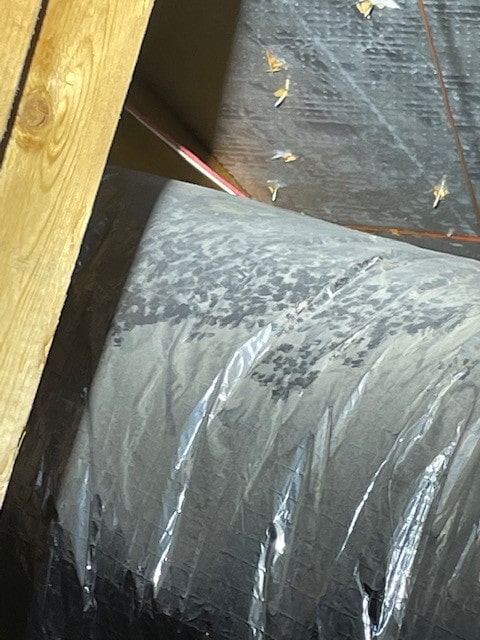Attics are large, unfinished spaces at the top of the house under the roof. The attic serves as a versatile space that contributes to the functionality, comfort, and efficiency of the home. Attics help with temperature regulation by providing insulation and ventilation. The unfinished space can hide bulky equipment like HVAC units and offers a space for storage.
Homeowners don’t spend much time in these hot and humid spaces, but those conditions make them ideal nesting spots for critters. Animals like raccoons, squirrels, and bats find their way into attics, looking for safe places to create dens and nests. You will rarely see the animal in your attic, but you will notice it. It can be hard to ignore an animal in your attic.
Animals in Attic Signs
Noises in the Attic
The first sign you’ll likely encounter is any noises coming from the attic. Noise will alert you that animals are in the attic.
The time of day can help you narrow down the list of suspects. For example, raccoons are nocturnal, which means you’ll primarily hear their noises at night. But squirrels might create noise throughout the day when popping in and out to store food.
Additionally, the type of noise is a useful clue. If you hear chirping, then it’s likely birds in your attic. But if you hear tiny feet scampering, you might have small rodents on your hands.
Animal Waste
After you hear noises, you may want to pop your head into the attic to confirm the presence of a critter. Although you might not see the animal itself, you’ll likely find some evidence of its presence.
Specifically, look for feces, guano, and animal waste. At the very least, animal feces will confirm that you have a critter problem. But if you can identify the droppings, then you can identify the animal species.
Strange Smells
One of the most common smells associated with animals in the attic is the odor. Different animals have distinct urine smells, but generally, they can be quite strong and pungent. Animal droppings can emit a foul smell that worsens over time as they accumulate. The smell can range from musty to downright putrid, depending on the type of animal and the state of decomposition.
In addition to animal droppings, animals in the attic can cause a variety of smells, depending on factors such as the type of animal, its waste, and the duration of its presence. Here are some common odors associated with animals in the attic:
- Nesting Materials: Animals often bring in nesting materials like leaves, twigs, and other debris. Over time, these materials can decay and emit musty or moldy odors, especially if they become damp.
- Body Oils and Grease: Some animals, such as rodents, leave behind body oils and grease as they move around. These oils can accumulate on surfaces and emit a distinctive, unpleasant smell.
- Mold and Mildew: Animal activity in the attic can lead to increased moisture levels, which in turn can promote the growth of mold and mildew. These fungi emit musty odors that can be a sign of a larger problem with moisture and ventilation.
- Food Odors: Animals may bring food into the attic to eat or store for later. Over time, this can lead to the growth of bacteria and the emission of unpleasant food odors.
- Decomposition: If an animal dies in the attic, As the body first begins to decompose, the smell may be localized and not as strong, but after a couple of days, it will become overpowering. The smell of decomposition can quickly become overpowering. It’s a sickly-sweet odor that is hard to ignore and indicates a more serious problem that needs immediate attention.
Rub Marks


Nuisance wildlife often leave rub marks as they move around your home. These marks typically appear as dark smudges or streaks on exterior surfaces such as walls, siding, and trim. The rub marks are caused by the natural oils and dirt on the animal’s fur transferring onto the surfaces as they repeatedly rub or brush against them.
Common locations for rub marks include entry points, such as gaps around doors and windows, as well as along travel routes and near nesting sites. These marks can vary in size and intensity depending on the type and size of the animal, with larger animals like raccoons and squirrels leaving more noticeable marks.
Identifying rub marks on your house can serve as an indication of wildlife activity and potential entry points, prompting homeowners to take action to prevent further damage and intrusion.
Animal Tracks or Runs



Animals in the attic will leave behind evidence of their movement.
Another indicator that animals will leave behind is paw prints on your ductwork. Opossums and raccoons have the biggest prints. They each have five fingers, but the palm of an opossum’s print is more triangular. Squirrels and rats have much smaller prints with their front feet having four toes and their hind feet having five.
When dealing with mice, rats, and even flying squirrels, you might see tunneling in an attic’s insulation. Typical tunnels are about three inches in diameter.
Animal Damage






Beyond waste and noises, any damage is another way to confirm that a critter is living in your attic. If left unchecked, these critters can cause not only noise but damage as well. Stored items in your attic are at risk for nuisance wildlife damage. Squirrels and rats will use cardboard boxes and their contents to create nests.
Animals will destroy insulation. Raccoons will dig up insulation to create nests. Norway rats create burrows through it. Any animal in the attic will contaminate the insulation with feces and urine.
https://www.crittercontrol.com/blog/raccoons-signs/Raccoons will often tear up ductwork or wallpaper. Rodents chew the wood and the electrical wires—creating potential fire hazards—and rats will live in your attic, breeding in high numbers. Frayed electrical wires are a significant fire hazard.